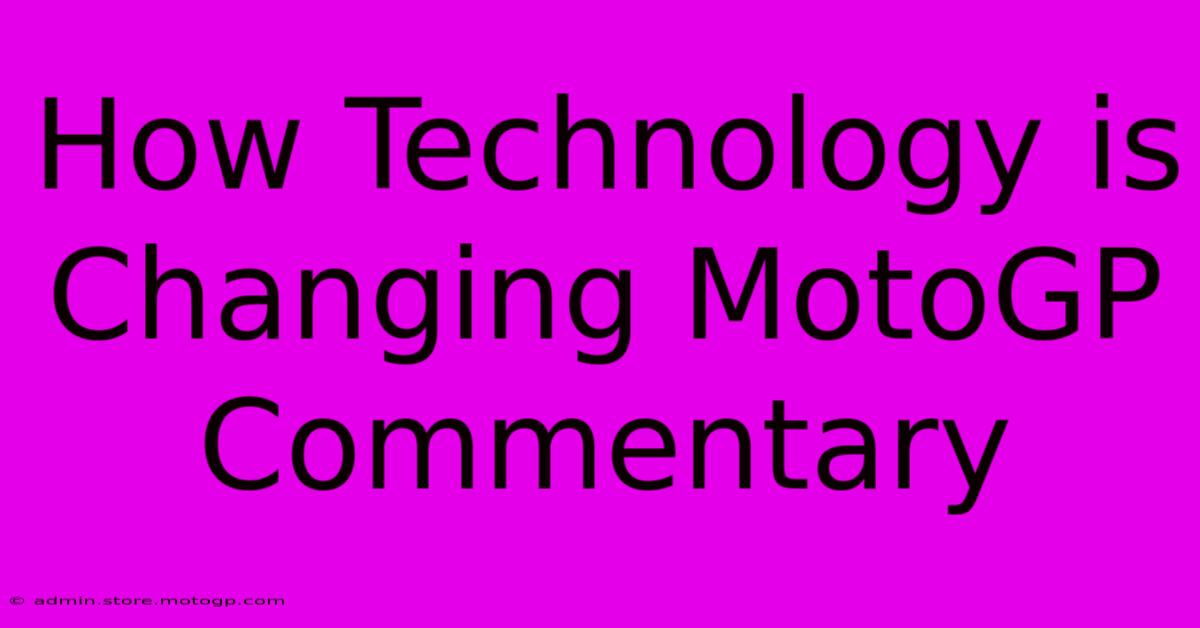How Technology Is Changing MotoGP Commentary

Table of Contents
How Technology is Changing MotoGP Commentary
MotoGP, the pinnacle of motorcycle racing, isn't just about the thrilling on-track action. The commentary plays a vital role in bringing the race to life for millions of viewers worldwide. But the way we experience this commentary is undergoing a rapid transformation thanks to technological advancements. This article explores how technology is revolutionizing MotoGP commentary, enhancing the viewing experience for fans.
Enhanced Data Visualization: Beyond the Naked Eye
Gone are the days of relying solely on the commentator's observations. Technology now provides a wealth of real-time data, significantly enriching the commentary. Sophisticated graphics overlay the live feed, displaying crucial information such as:
- Speed: Precise speed readings for each rider, highlighting overtaking maneuvers and strategic advantages.
- Lap times: Live comparison of lap times, showcasing the battle for positions and potential race outcomes.
- Tire wear: Visual representations of tire degradation, offering insights into rider strategies and potential risks.
- GPS tracking: Detailed tracking of rider positions and trajectories, allowing commentators to pinpoint crucial moments and explain overtaking maneuvers in greater detail. This real-time data integration provides a layer of depth impossible to achieve without technology.
The impact of this data-driven commentary?
It allows commentators to move beyond simple observations and provide in-depth analysis, explaining the nuances of the race in a way that was previously impossible. Fans gain a deeper understanding of the strategic decisions made by riders and teams, making the racing far more engaging.
Immersive Audio Experiences: Hear the Race Like Never Before
Technology isn't just changing what we see during MotoGP commentary; it's transforming what we hear. Advanced audio technology is creating more immersive and engaging experiences:
- Ambisonic Sound: This technology allows for a more realistic and three-dimensional soundscape, placing viewers closer to the action. The roar of the engines, the squeal of tires, and the sounds of the crowd are more accurately represented, enhancing the feeling of being trackside.
- Personalized Audio: Some platforms offer personalized audio mixes, allowing viewers to adjust the balance between commentary, engine sounds, and ambient noise. This customization enables a more tailored and immersive viewing experience.
- Multiple Commentary Options: Viewers can choose from different language options or even select commentary from different perspectives (e.g., a technical expert versus a more generalist commentator). This caters to a broader audience and offers a greater depth of understanding.
The future of immersive audio
promises even more realistic and engaging soundscapes, further blurring the lines between watching the race on television and experiencing it in person.
Interactive Commentary: Engaging with the Audience
Technology is also bridging the gap between commentators and viewers. Interactive elements are becoming increasingly common:
- Social Media Integration: Commentators can interact directly with viewers via social media, responding to questions and comments during the race. This creates a more engaging and dynamic experience for the audience.
- Virtual Reality (VR) and Augmented Reality (AR): While still in its early stages, VR and AR have the potential to revolutionize MotoGP commentary. Imagine experiencing the race from the rider's perspective or seeing data visualizations overlaid onto the track in real-time.
The future of interactive commentary
is about fostering a sense of community, allowing fans to actively participate in the viewing experience.
AI's Role in Enhancing Commentary
Artificial intelligence (AI) is playing an increasingly significant role in MotoGP commentary. AI can be used to:
- Automate data analysis: AI algorithms can analyze vast amounts of data to identify key moments and patterns, helping commentators to focus on the most important aspects of the race.
- Generate real-time insights: AI can provide immediate commentary on specific events, such as close overtakes or unexpected incidents.
- Translate commentary: AI-powered translation tools can provide real-time translations of the commentary into multiple languages, widening the reach of MotoGP.
The responsible use of AI
in commentary is crucial, ensuring that it complements and enhances, rather than replaces, the human element.
In Conclusion:
Technology is dramatically altering the landscape of MotoGP commentary. From enhanced data visualization and immersive audio experiences to interactive elements and the growing role of AI, the way we experience the races is constantly evolving. These technological advancements not only provide a richer and more engaging experience for the fans but also deepen our understanding and appreciation of this exhilarating sport. The future of MotoGP commentary promises to be even more exciting and innovative.

Thank you for visiting our website wich cover about How Technology Is Changing MotoGP Commentary. We hope the information provided has been useful to you. Feel free to contact us if you have any questions or need further assistance. See you next time and dont miss to bookmark.
Featured Posts
-
F1 Tomorrow The Starting Grid That Could Change Everything
Feb 18, 2025
-
Unlock Your Potential Moto 3 Bike Training Tips
Feb 18, 2025
-
The Cota F1 Merch Collection Something For Everyone
Feb 18, 2025
-
From Dirt Tracks To Super Speedway Any Racing On Today
Feb 18, 2025
-
Moto Gp Austin 2025 Be A Part Of History
Feb 18, 2025
